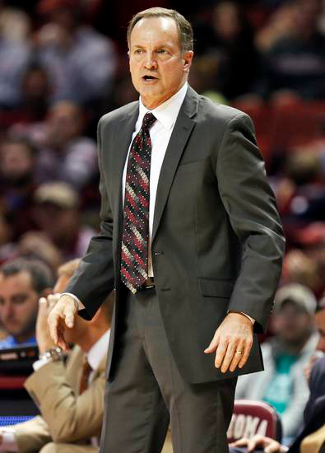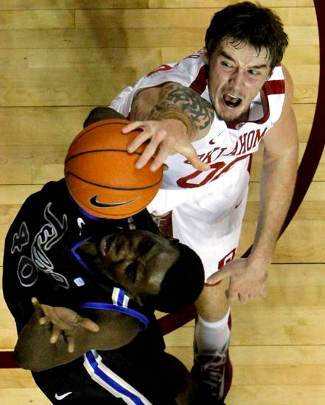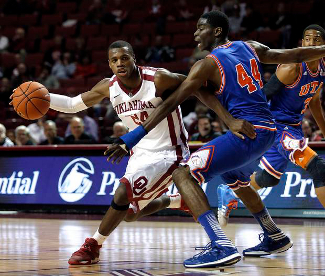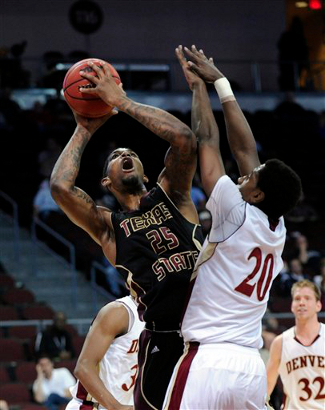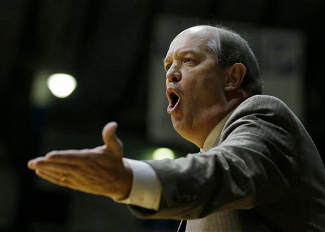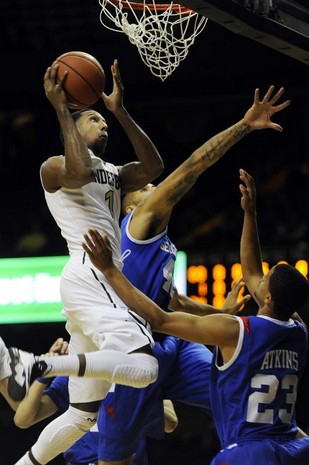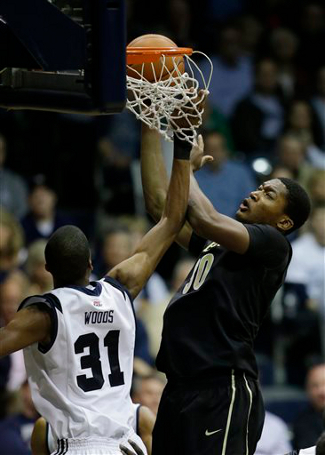Frank Erwin Center | Austin, TX | Tip: 7 P.M. CT | TV: LHN After a surprisingly strong non-conference campaign, the Texas Longhorns are ready to tip off against tougher competition in the Big 12. The Horns — who are the sixth-youngest team in Division I, according to Ken Pomeroy — reeled off 11 wins in 13 non-conference games, including an impressive road victory against a talented, albeit inconsistent, North Carolina team. Texas was not the only surprise team in the Big 12, though. Their opponents in tonight’s conference opener, the Oklahoma Sooners, have also posted an 11-2 mark. After losing three starters from last year’s team that went to the NCAA tournament, Oklahoma was expected to be a middle-of-the-pack team that might hang around on the bubble. Although the Sooners will probably still finish in the middle of the table in a fairly loaded Big 12, they have shown that even the top-tier teams in the league should be worried about playing them.
Lon Kruger has OU exceeding preseason expectations If the Sooners are truly going to live up to the new expectations they built in non-conference play, they will have to overcome some long odds in the first few weeks of the season. League schedule-makers did Lon Kruger no favors, giving the Sooners road trips to Texas, Kansas State, and Baylor in their first five games, while tabbing Kansas and Iowa State as the teams to visit Lloyd-Noble during that stretch. Making an early statement in the Big 12 would be quite impressive for OU, given that opening gauntlet. Pomeroy gives the Sooners odds of no greater than 39% to win any of their first five games, with OU having a 32% chance to win tonight’s tilt in Austin, their most-winnable of the three road games. Looking at the cumulative odds for that stretch shows that Pomeroy gives the Sooners a 15% chance to be sitting at 0-5 in league play on January 19th. By the numbers Texas fans have seen some up-tempo basketball from the Horns this season, but it has been nothing compared to the track meets going on in Norman. Oklahoma has the ninth-fasted adjusted tempo in D-I hoops, according to Pomeroy, squeezing in 74.6 possessions per game. With the Horns having 72 possessions per game, fans should be treated to some exciting, up-and-down action tonight. Oklahoma plays with a four-out, one-in look, but the team still has fared pretty well on the offensive glass. The Sooners have reclaimed nearly 35% of their missed shots, thanks in large part to guards and wings that rebound really well for their size. Oklahoma did have trouble when they played a much larger Michigan State team, as they won only 20.5% of their offensive rebounding chances in that game. Against the size of Texas’ frontcourt, OU could face similar struggles tonight. Keeping the Sooners away from offensive rebounds will be especially important for Texas tonight because Oklahoma generally doesn’t miss very many shots to begin with. OU’s effective field-goal percentage of 53% ranks them 56th in the country, and it’s not a number inflated by layups. OU has a handful of good shooters who can knock down midrange looks and they are also accurate behind the arc, even though a long-range attack isn’t a key aspect of their gameplans. All told, the Sooners score an adjusted 1.14 points per possession. Although their defensive numbers of 1.032 adjusted PPP are just a shade below the national average, that per-possession disparity adds up in a hurry when the game is played at Oklahoma’s pace. Since Texas loves to play nearly as quickly as the Sooners do, the Longhorn defense will have to step up tonight. The Texas offense is simply not reliable enough to keep up with Oklahoma’s if the Sooners are scoring at their usual rate.
Ryan Spangler is Oklahoma’s lone presence inside Meet the Sooners Oklahoma lacks the interior size it enjoyed with Amath M’Baye and Romero Osby last season, so Coach Kruger has adjusted his approach this season. The Sooners typically trot out only one big a time, with former Gonzaga Bulldog Ryan Spangler (No. 00) holding that role in the starting five, despite checking in at just 6’8″. Spangler plays much bigger than his listed height, providing excellent interior defense and great performances on the glass. The sophomore has scored a ton of hoops on tip-ins this season and has a defensive rebounding rate of 23.8%, ranking him 73rd in Division I. Spangler has also shown the ability to face up opposing forwards and centers and take them off the bounce, but he has yet to prove that he has much of a shot. Teams can easily turn him into a one-dimensional threat by giving him space anytime he leaves the block, but they must always be aware of his location on the floor so they can get a body on him as soon as a shot goes up. The team’s leading scorer is senior Cameron Clark (No. 21), an exciting player who averages 18.5 points per game, or roughly 21% of OU’s scoring. Clark made a splash as a sophomore before returning to a reserve role on last year’s loaded squad and ultimately ascending to the leadership role in his senior year. He is an incredibly athletic player who has always been known for his highlight-reel dunks, but he also has a good shot that is accurate all over the floor. Although his midrange game can be streaky at times, Clark has made 50% of his threes, but averages less than three of those attempts per game. Even though Clark can sometimes go through cold spells from the midrange, he always finds a way to score. In Monday night’s overtime loss to Louisiana Tech, the senior was just 7-of-17 from the floor, but repeatedly attacked the basket to earn trips to the line. He also proved just how clutch of a player he can be when he grabbed an airballed three and raced out to the perimeter to hit his own game-tying, fadeaway triple with just 0.6 seconds left on the clock in regulation. OU’s other aggressive scorer is sophomore guard Buddy Hield (No. 24). Hailing from the Bahamas, Hield has a good understanding of how to vary his speeds to beat the defense, and he has great strength and body control to score through contact. Like all of the Oklahoma guards, Hield is also very good at passing while driving to the hoop, often setting up Spangler underneath or kicking out to open teammates for midrange jumpers or threes. Freshman point guard Jordan Woodard (No. 10) has been very impressive in his first year at Oklahoma, but he is coming off of the roughest outing of his young career. In the loss to Louisiana Tech, Woodard coughed it up eight times against just two assists, and made only 31% of his shots. Typically, he is another aggressive perimeter player for the Sooners, repeatedly attacking the rim for easy points or trips to the free throw line. Like Hield, Woodard’s driving ability often opens things up for little dumpoffs in the paint or kickouts to open teammates, and his personal assist rate of 26.9% ranks him in the Top 200 nationally. Sophomore guard Isaiah Cousins (No. 11) rounds out the starting five for Oklahoma, and he is yet another solid shooter for the Sooners. He doesn’t take many three-point attempts, but has made 41.4% of his tries this season. Understandably, Cousins fires up a few more from long range when he’s feeling it, so he usually knocks down two or three if he makes any. Cousins is also an excellent defender, thanks to quick hands, good footwork, and length that can clog passing lanes and make it tough for smaller guards. He often comes up with a nice swipe or two in each game by knocking it away from an oblivious rebounder or by stripping opponents when providing help defense. Many teams have been flustered by Oklahoma’s active defense, and Cousins’ skills on that end of the court are a big reason why. Keys to the game
Texas has to stop the drives of Hield and the OU guards 1) Limit penetration – Although they have good shooters, everything starts with dribble penetration for the Sooners. If Texas can limit the number of times Oklahoma beats them with the bounce, it forces the Sooners into taking challenged jumpers instead of allowing wide-open looks on kickouts. The Sooners still have the shooters to knock down some of those tough looks, but if the Longhorns want to keep Oklahoma from lighting up the scoreboard, they have to keep the OU guards in front of them. 2) Win transition battle – Both teams like to get the ball up the court in a hurry and score easy points before the defense is set, so tonight’s game could very well come down to which team is able to get more fast break buckets. The Longhorn defense can’t afford to give up transition hoops to an offense that is already going to be tough to stop, and their offense certainly needs to get as many points as it can without having to score in the half-court. 3) Exploit size advantage – The Longhorns are going to enjoy a definitive size advantage in this one, although they will likely have to use Cameron Ridley in short spurts thanks to the tempo of the game. Exploiting that size advantage is easier said than done, however. Oklahoma loves to trap and swarm everywhere on the court, but especially on the blocks. The Texas bigs have had issues this season with slow decision-making, something that will be deadly against a pressure defense. Not only do the Longhorn bigs need to be quick and decisive with the ball on the block, but they will also need to contribute in the pick-and-roll game. Clark will likely be tasked with guarding Jonathan Holmes or Connor Lammert, which is already a size mismatch in favor of Texas. Add in OU’s preference for switching on ball screens, and Texas has a great opportunity to get Lammert and Holmes quite a few points as they crash to the hoop against smaller guards. |








